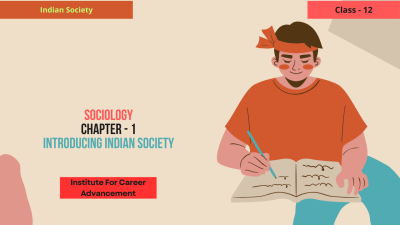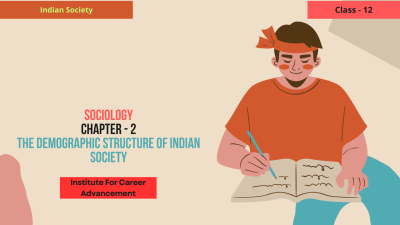Course description
The Class 11 Sociology chapter on "Sociology, Society, and its Relationship with Other Social Science Disciplines" introduces students to the field of sociology, its distinct approach to studying society, and how it interacts with other social science disciplines. The course emphasizes the interdisciplinary nature of sociology and its relevance in understanding complex social phenomena.
1. Introduction to Sociology
Definition of Sociology: The study of human society, social behavior, and social institutions.
Nature of Sociology: Its scientific approach to understanding human behavior in a social context, using both empirical data and theoretical analysis.
Scope of Sociology: Analyzing social structures, institutions, relationships, and the dynamics of human interactions.
2. Society: Meaning and Characteristics
Definition of Society: A system of interdependent relationships among individuals and groups.
Key characteristics of society: Social organization, interdependence, shared values, norms, culture, and social institutions.
Understanding social structure: The framework within which social interactions take place, including institutions like family, education, religion, and economy.
3. Sociology and its Relationship with Other Social Science Disciplines
Sociology and Anthropology: Sociology focuses on contemporary social structures and institutions, while anthropology traditionally studies human societies, cultures, and evolutionary aspects, especially in historical or non-Western contexts.
Sociology and Political Science: Political science deals with the study of governance, power, and political institutions, while sociology examines the impact of politics on society and how social movements influence political processes.
Sociology and Economics: Economics studies the production, distribution, and consumption of goods and services, while sociology looks at the broader social context in which economic activities occur, including inequality, labor markets, and consumption patterns.
Sociology and History: History focuses on past events and social transformations over time, while sociology studies the patterns and structures that shape contemporary societies. Sociology often uses historical data to understand current social issues.
Sociology and Psychology: Psychology focuses on individual behavior and mental processes, while sociology examines how social influences, interactions, and institutions shape human behavior on a collective level.
Sociology and Geography: Geography studies the spatial distribution of human activity and natural phenomena, while sociology explores how these spatial patterns influence social structures and relationships (e.g., urbanization, migration).
4. Importance of Studying Sociology
Critical understanding of society: Sociology enables students to critically analyze how societies function, how social norms and institutions shape human behavior, and how change occurs in society.
Sociological imagination: Encouraging students to view personal experiences within the broader context of societal structures, patterns, and historical forces.
Empowerment through knowledge: Sociology helps individuals understand societal problems such as inequality, discrimination, and poverty, fostering informed citizens who can contribute to social change.
5. Sociological Perspectives and Theories
Functionalism: Views society as a complex system with various parts that work together to promote stability and social order (e.g., Emile Durkheim's work on social institutions).
Conflict Theory: Focuses on power struggles, inequality, and social change, highlighting how society is marked by conflicts between dominant and marginalized groups (e.g., Karl Marx’s analysis of class conflict).
Symbolic Interactionism: Emphasizes the importance of social interactions and the meanings individuals attach to their behavior and society (e.g., the work of George Herbert Mead).
Feminist Theory: Explores gender inequality, patriarchy, and the ways in which gender roles are socially constructed and maintained.
6. Methods of Sociological Research
Quantitative Methods: Use of surveys, questionnaires, and statistical analysis to study social patterns.
Qualitative Methods: Participant observation, in-depth interviews, and case studies to understand social phenomena from the perspective of individuals.
Comparative Methods: Comparing different societies or social groups to understand similarities and differences in social behavior.
7. Understanding the Social Context
Culture and Society: Examining how culture shapes social behavior, including norms, values, symbols, and language.
Socialization: The process by which individuals learn and internalize the norms, values, and behaviors appropriate to their society.
Social Institutions: Studying key institutions such as family, education, religion, and government, and their role in maintaining social order.
"সমাজবিজ্ঞান, সমাজ এবং অন্যান্য সামাজিক বিজ্ঞান শাখার সঙ্গে এর সম্পর্ক" শীর্ষক 11 তম শ্রেণীর সমাজবিজ্ঞান অধ্যায়টি শিক্ষার্থীদের সমাজবিজ্ঞানের ক্ষেত্র, সমাজ অধ্যয়নের ক্ষেত্রে এর স্বতন্ত্র দৃষ্টিভঙ্গি এবং অন্যান্য সামাজিক বিজ্ঞানের শাখার সাথে এটি কীভাবে যোগাযোগ করে সে সম্পর্কে পরিচয় করিয়ে দেয়। কোর্সটি সমাজবিজ্ঞানের আন্তঃবিষয়ক প্রকৃতি এবং জটিল সামাজিক ঘটনা বোঝার ক্ষেত্রে এর প্রাসঙ্গিকতার উপর জোর দেয়।
1টি। সমাজবিজ্ঞানের পরিচিতি
সমাজবিজ্ঞানের সংজ্ঞাঃ মানব সমাজ, সামাজিক আচরণ এবং সামাজিক প্রতিষ্ঠানের অধ্যয়ন।
সমাজবিজ্ঞানের প্রকৃতিঃ পরীক্ষামূলক তথ্য এবং তাত্ত্বিক বিশ্লেষণ উভয়ই ব্যবহার করে সামাজিক প্রেক্ষাপটে মানুষের আচরণ বোঝার জন্য এর বৈজ্ঞানিক পদ্ধতি।
সমাজবিজ্ঞানের পরিধিঃ সামাজিক কাঠামো, প্রতিষ্ঠান, সম্পর্ক এবং মানুষের মিথস্ক্রিয়ার গতিশীলতা বিশ্লেষণ করা।
2. সমাজঃ অর্থ এবং বৈশিষ্ট্য
সমাজের সংজ্ঞাঃ ব্যক্তি ও গোষ্ঠীর মধ্যে আন্তঃনির্ভরশীল সম্পর্কের একটি ব্যবস্থা।
সমাজের প্রধান বৈশিষ্ট্যঃ সামাজিক সংগঠন, পারস্পরিক নির্ভরতা, অভিন্ন মূল্যবোধ, নিয়ম, সংস্কৃতি এবং সামাজিক প্রতিষ্ঠান।
সামাজিক কাঠামো বোঝাঃ যে কাঠামোর মধ্যে পরিবার, শিক্ষা, ধর্ম এবং অর্থনীতির মতো প্রতিষ্ঠানগুলি সহ সামাজিক মিথস্ক্রিয়া ঘটে।
3. সমাজবিজ্ঞান এবং অন্যান্য সামাজিক বিজ্ঞান শাখার সাথে এর সম্পর্ক
সমাজবিজ্ঞান এবং নৃতত্ত্বঃ সমাজবিজ্ঞান সমসাময়িক সামাজিক কাঠামো এবং প্রতিষ্ঠানগুলির উপর দৃষ্টি নিবদ্ধ করে, যেখানে নৃতত্ত্ব ঐতিহ্যগতভাবে মানব সমাজ, সংস্কৃতি এবং বিবর্তনীয় দিকগুলি অধ্যয়ন করে, বিশেষ করে ঐতিহাসিক বা অ-পশ্চিমা প্রেক্ষাপটে।
সমাজবিজ্ঞান এবং রাষ্ট্রবিজ্ঞানঃ রাষ্ট্রবিজ্ঞান শাসন, ক্ষমতা এবং রাজনৈতিক প্রতিষ্ঠানগুলির অধ্যয়ন নিয়ে কাজ করে, অন্যদিকে সমাজবিজ্ঞান সমাজে রাজনীতির প্রভাব এবং সামাজিক আন্দোলনগুলি কীভাবে রাজনৈতিক প্রক্রিয়াগুলিকে প্রভাবিত করে তা পরীক্ষা করে।
সমাজবিজ্ঞান ও অর্থনীতিঃ অর্থনীতি পণ্য ও পরিষেবার উৎপাদন, বন্টন এবং ব্যবহার নিয়ে অধ্যয়ন করে, অন্যদিকে সমাজবিজ্ঞান বৈষম্য, শ্রম বাজার এবং ভোগের ধরণ সহ অর্থনৈতিক ক্রিয়াকলাপগুলি ঘটে এমন বিস্তৃত সামাজিক প্রেক্ষাপটের দিকে নজর দেয়।
সমাজবিজ্ঞান এবং ইতিহাসঃ ইতিহাস অতীতের ঘটনা এবং সময়ের সাথে সামাজিক রূপান্তরের উপর দৃষ্টি নিবদ্ধ করে, অন্যদিকে সমাজবিজ্ঞান সমসাময়িক সমাজকে রূপদানকারী নিদর্শন এবং কাঠামো অধ্যয়ন করে। সমাজবিজ্ঞান প্রায়শই বর্তমান সামাজিক সমস্যাগুলি বোঝার জন্য ঐতিহাসিক তথ্য ব্যবহার করে।
সমাজবিজ্ঞান এবং মনোবিজ্ঞানঃ মনোবিজ্ঞান ব্যক্তিগত আচরণ এবং মানসিক প্রক্রিয়াগুলির উপর দৃষ্টি নিবদ্ধ করে, অন্যদিকে সমাজবিজ্ঞান কীভাবে সামাজিক প্রভাব, মিথস্ক্রিয়া এবং প্রতিষ্ঠানগুলি সম্মিলিত স্তরে মানুষের আচরণকে রূপ দেয় তা পরীক্ষা করে।
সমাজবিজ্ঞান এবং ভূগোলঃ ভূগোল মানব ক্রিয়াকলাপ এবং প্রাকৃতিক ঘটনাগুলির স্থানিক বিতরণ অধ্যয়ন করে, অন্যদিকে সমাজবিজ্ঞান অনুসন্ধান করে যে কীভাবে এই স্থানিক নিদর্শনগুলি সামাজিক কাঠামো এবং সম্পর্কগুলিকে প্রভাবিত করে। (e.g., urbanization, migration).
4. সমাজবিজ্ঞান অধ্যয়নের গুরুত্ব
সমাজের সমালোচনামূলক বোধগম্যতাঃ সমাজবিজ্ঞান শিক্ষার্থীদের সমাজ কীভাবে কাজ করে, সামাজিক নিয়ম ও প্রতিষ্ঠানগুলি কীভাবে মানুষের আচরণকে রূপ দেয় এবং সমাজে কীভাবে পরিবর্তন ঘটে তা সমালোচনামূলকভাবে বিশ্লেষণ করতে সক্ষম করে।
সমাজতাত্ত্বিক কল্পনাঃ শিক্ষার্থীদের সামাজিক কাঠামো, নিদর্শন এবং ঐতিহাসিক শক্তির বিস্তৃত প্রেক্ষাপটে ব্যক্তিগত অভিজ্ঞতাগুলি দেখতে উত্সাহিত করা।
জ্ঞানের মাধ্যমে ক্ষমতায়নঃ সমাজবিজ্ঞান ব্যক্তিদের অসমতা, বৈষম্য এবং দারিদ্র্যের মতো সামাজিক সমস্যাগুলি বুঝতে সাহায্য করে, জ্ঞাত নাগরিকদের উৎসাহিত করে যারা সামাজিক পরিবর্তনে অবদান রাখতে পারে।
5. সমাজতাত্ত্বিক দৃষ্টিভঙ্গি ও তত্ত্ব
কার্যকারিতাবাদঃ সমাজকে বিভিন্ন অংশের সাথে একটি জটিল ব্যবস্থা হিসাবে দেখে যা স্থিতিশীলতা এবং সামাজিক শৃঙ্খলা প্রচারের জন্য একসাথে কাজ করে (e.g., সামাজিক প্রতিষ্ঠানগুলিতে এমিল ডুরখেইমের কাজ)
দ্বন্দ্ব তত্ত্বঃ ক্ষমতার সংগ্রাম, বৈষম্য এবং সামাজিক পরিবর্তনের উপর দৃষ্টি নিবদ্ধ করে, সমাজ কীভাবে প্রভাবশালী এবং প্রান্তিক গোষ্ঠীর মধ্যে দ্বন্দ্ব দ্বারা চিহ্নিত হয় তা তুলে ধরে (e.g., শ্রেণী দ্বন্দ্বের কার্ল মার্ক্সের বিশ্লেষণ)
প্রতীকী মিথস্ক্রিয়াবাদঃ সামাজিক মিথস্ক্রিয়ার গুরুত্ব এবং ব্যক্তিরা তাদের আচরণ এবং সমাজের সাথে সংযুক্ত অর্থের উপর জোর দেয় (e.g., the work of George Herbert Mead).
নারীবাদী তত্ত্বঃ লিঙ্গ বৈষম্য, পিতৃতন্ত্র এবং লিঙ্গ ভূমিকা সামাজিকভাবে নির্মিত এবং বজায় রাখার উপায়গুলি অন্বেষণ করে।
6টি। সমাজতাত্ত্বিক গবেষণা পদ্ধতি
পরিমাণগত পদ্ধতিঃ সামাজিক নিদর্শন অধ্যয়নের জন্য সমীক্ষা, প্রশ্নাবলী এবং পরিসংখ্যানগত বিশ্লেষণের ব্যবহার।
গুণগত পদ্ধতিঃ ব্যক্তিদের দৃষ্টিকোণ থেকে সামাজিক ঘটনাগুলি বোঝার জন্য অংশগ্রহণকারী পর্যবেক্ষণ, গভীর সাক্ষাৎকার এবং কেস স্টাডি।
তুলনামূলক পদ্ধতিঃ সামাজিক আচরণে সাদৃশ্য এবং পার্থক্য বোঝার জন্য বিভিন্ন সমাজ বা সামাজিক গোষ্ঠীর তুলনা করা।
7. সামাজিক প্রেক্ষাপট বোঝা
সংস্কৃতি ও সমাজঃ সংস্কৃতি কীভাবে নিয়ম, মূল্যবোধ, প্রতীক এবং ভাষা সহ সামাজিক আচরণকে রূপ দেয় তা পরীক্ষা করা।
সামাজিকীকরণঃ এমন একটি প্রক্রিয়া যার মাধ্যমে ব্যক্তিরা তাদের সমাজের জন্য উপযুক্ত নিয়ম, মূল্যবোধ এবং আচরণগুলি শেখে এবং অভ্যন্তরীণ করে।
সামাজিক প্রতিষ্ঠানঃ পরিবার, শিক্ষা, ধর্ম ও সরকারের মতো মূল প্রতিষ্ঠানগুলি এবং সামাজিক শৃঙ্খলা বজায় রাখতে তাদের ভূমিকা অধ্যয়ন করা।



















